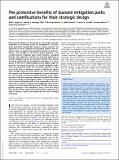| dc.contributor.author | Lunghino, Brent | |
| dc.contributor.author | Santiago Tate, Adrian F | |
| dc.contributor.author | Mazereeuw, Miho | |
| dc.contributor.author | Muhari, Abdul | |
| dc.contributor.author | Giraldo, Francis X | |
| dc.contributor.author | Marras, Simone | |
| dc.contributor.author | Suckale, Jenny | |
| dc.date.accessioned | 2021-10-27T19:58:06Z | |
| dc.date.available | 2021-10-27T19:58:06Z | |
| dc.date.issued | 2020 | |
| dc.identifier.uri | https://hdl.handle.net/1721.1/134099 | |
| dc.description.abstract | © 2020 National Academy of Sciences. All rights reserved. Nature-based solutions are becoming an increasingly important component of sustainable coastal risk management. For particularly destructive hazards like tsunamis, natural elements like vegetation are often combined with designed elements like seawalls or dams to augment the protective benefits of each component. One example of this kind of hybrid approach is the so-called tsunami mitigation park, which combines a designed hillscape with vegetation. Despite the increasing popularity of tsunami mitigation parks, the protective benefits they provide are poorly understood and incompletely quantified. As a consequence of this lack of understanding, current designs might not maximize the protective benefits of tsunami mitigation parks. Here, we numerically model the interactions between a single row of hills with an incoming tsunami to identify the mechanisms through which the park protects the coast. We initialize the tsunami as an N wave that propagates to shore and impacts the coast directly. We find that partial reflection of the incoming wave is the most important mechanism by which hills reduce the kinetic energy that propagates onshore. The protective benefit of tsunami mitigation parks is thus comparable to that of a small wall, at least for tsunamis with amplitudes that are comparable to the hill height. We also show that hills could elevate potential damage in the immediate vicinity of the hills where flow speeds increase compared to a planar beach, suggesting the need to include a buffer zone behind the hills into a strategic park design. | |
| dc.language.iso | en | |
| dc.publisher | Proceedings of the National Academy of Sciences | |
| dc.relation.isversionof | 10.1073/pnas.1911857117 | |
| dc.rights | Article is made available in accordance with the publisher's policy and may be subject to US copyright law. Please refer to the publisher's site for terms of use. | |
| dc.source | PNAS | |
| dc.title | The protective benefits of tsunami mitigation parks and ramifications for their strategic design | |
| dc.type | Article | |
| dc.contributor.department | Massachusetts Institute of Technology. Department of Architecture | |
| dc.relation.journal | Proceedings of the National Academy of Sciences of the United States of America | |
| dc.eprint.version | Final published version | |
| dc.type.uri | http://purl.org/eprint/type/JournalArticle | |
| eprint.status | http://purl.org/eprint/status/PeerReviewed | |
| dc.date.updated | 2021-05-07T18:54:16Z | |
| dspace.orderedauthors | Lunghino, B; Santiago Tate, AF; Mazereeuw, M; Muhari, A; Giraldo, FX; Marras, S; Suckale, J | |
| dspace.date.submission | 2021-05-07T18:54:20Z | |
| mit.journal.volume | 117 | |
| mit.journal.issue | 20 | |
| mit.license | PUBLISHER_POLICY | |
| mit.metadata.status | Authority Work and Publication Information Needed | |
